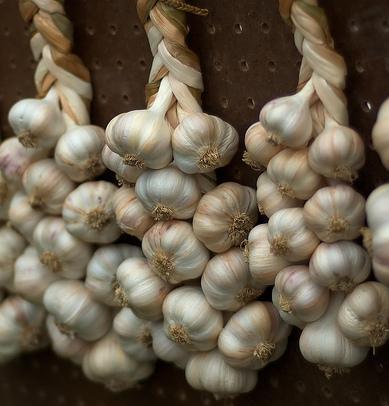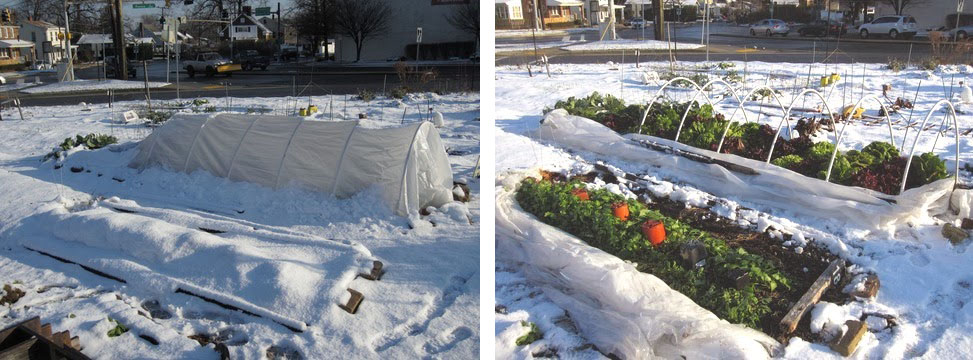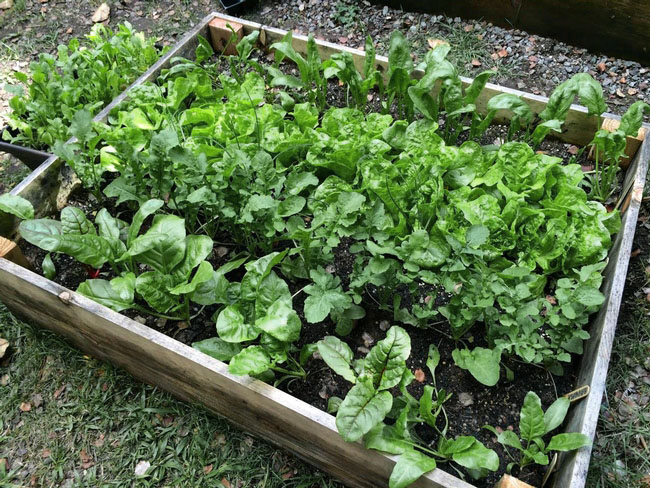Winter Gardening
By Janet Scheren, Fairfax Master Gardener Intern
There is just nothing as tasty as fresh produce from your garden. If you’ve gotten used to eating the sumptuous fruits (and vegetables and greens) of your labor each day, you may be looking at the winter months ahead with a long face. But fear not. There are several strategies you can employ to preserve your harvest, extend the fall growing season, grow cold-tolerant crops for midwinter harvest and prepare for continuity into early spring.
 Storing Your Summer Harvest
Storing Your Summer Harvest
Many of our summer crops can be stored for great eating for many months to come. Onions, garlic and shallots can be dried and braided. Winter squash, pumpkins and potatoes have a long shelf life when seasoned and stored properly, with butternut squash storing up to a year. Tomatoes and other fruits can be canned, dried or made into chutneys. Cucumbers and many other vegetables can be pickled. Several vegetables can be fermented to provide super nutrition — think sauerkraut or kimchee. Green beans and such can be parboiled, vacuum sealed and frozen. Herbs can be dried. Basil can be made into pesto, then frozen in small batches for later use. Some root vegetables, such as carrots, parsnips and turnips, can be stored in damp sand in a shed or unheated garage. Now is the time to stock your larder!
It’s also time to be sure your soil is protected to prevent erosion and soil depletion during the winter months. Winter rye is probably the best choice left if you are harvesting crops in late October or early November. Beyond this window in time, your best option may be to heavily mulch the soil with straw and cover that with an old blanket or cloth. This will help your soil retain its structure, moderating how much moisture seeps into it and reducing compaction from rainfall.
Protecting Plants from Early Frosts
In Zone 7a we typically experience our first frost between October 25 and November 5. As of this writing, the forecast through November 10 includes only a couple of nights where the temps drop close to 32 degrees. A cloche, frost blanket or row cover can be used to extend the fall growing season for many crops, while nighttime temperatures flirt with freezing ones and days are still reasonably warm. This gives a bit more time to ripen and harvest crops before really cold weather sets in. The goal is to keep frost from settling on the leaves and to create a buffer of warmer air around the plant. For smaller plants, even a plastic bin can do the trick. Place the bucket, bin or cloche on the plant in late afternoon and remove it when the temperatures warm up the next morning.

Winter cloche
Some crops are tough enough to handle winter weather but appreciate the buffer provided by a row cover. These include kale, spinach, leeks, arugula, some lettuces, tatsoi (an Asian green), pak choy, parsley, cilantro, leeks, cabbage, mustard greens, purple sprouting broccoli and beets.
For the more adventurous gardener, cold frames can be the next line of defense. Cold frames can be easily constructed by using 2 by 4 lumber and a clear 6 mil or preferably 8 mil vinyl sheeting or polymer film. The frame should have a sloped top that can be wedged open as needed for ventilation or watering. For best results, locate your cold frame in a sheltered area of your garden with the sloped top facing south. Southern and southeastern exposures warm up the bed early with morning sun.
While covers vary in their insulation value, most can add three to five degrees to the air temperatures, thus making them effective on nights when the temperatures drop as low as 28 degrees. Be sure your covers are secured to the ground with weights or ties to ensure cold air can’t seep underneath and heat can’t escape.
For the next level of winter defense, hot beds and greenhouses can be employed to extend the growing season for frost sensitive plants even later in the season. Hot beds can be used to keep the soil a bit warmer during the cold months. These can be as simple as digging soil out about 2 feet deep and layering 18 inches of fairly fresh horse manure mixed with straw and then covering it with 6 inches of good garden soil. Another strategy uses electric heating cables covered by landscape cloth and sand.

Spinach, lettuce, chard in winter
In zone 7a, our climate is mild enough to grow some hardy greens and root vegetables most years through at least the early winter months. Some crops are typically winter hardy without any additional protection except a good layer of mulch. These include Brussels sprouts, carrots, collards, spinach, turnips, garlic and perennial onions. Carrots can be left in the ground and harvested as needed, typically until mid-winter.
Location, Location, Location
Frost and pockets of cold air collect in low-laying areas of your garden. Cold winter winds blow from the Northwest. Locate your winter garden beds to avoid these chilly spots.
Now Is the Time to Plan for Spring
While your focus may be on getting through December and January, February and March aren’t far behind. And our cold weather can extend through April. Hot beds and row covers can be used here as well to get an early start on spring planting. Broad beans, purple sprouting broccoli, rhubarb, carrots, peas, strawberries and even bush beans can be planted in covered hot beds in January and be ready to harvest as early as March. This helps to stave off the hunger gap between winter harvest and lush spring crops that aren’t typically ready to harvest until May.
Resources
Home Vegetable Gardening, Virginia Cooperative Extension
Season Extenders, Virginia Cooperative Extension
Grow Great Virginia Vegetables, Ira Wallace, Timber Press, 2020
Ask an Expert: Five Ways to Protect Plants from Dipping Temperatures, Utah State University Extension